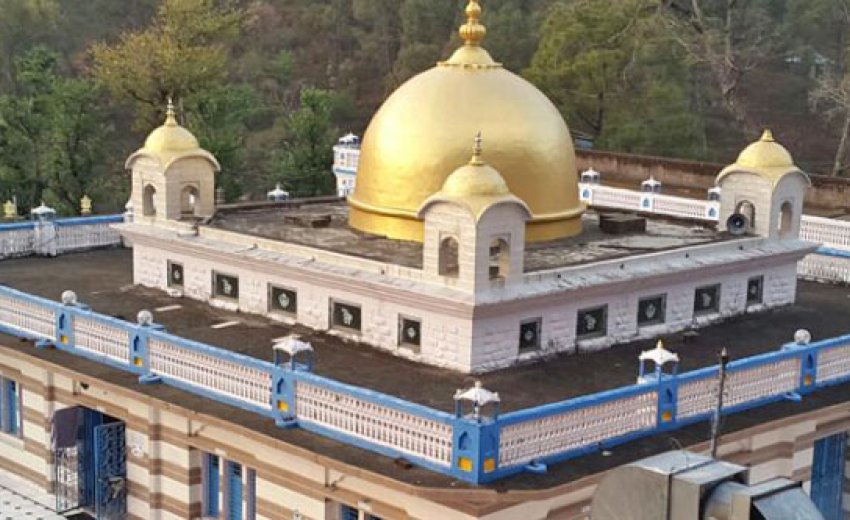In his seminal work "Mahankosh," Bhai Kahn Singh Nabha sheds light on the historical significance of Rawalsar, a place where Guru Gobind Singh ji addressed the hill rajas (rulers) in 1701.
Rawalsar is a small but significant town located just a short distance away from Mandi in the state of Himachal Pradesh. It holds great importance for followers of the Sikh religion. Many years ago, Guru Gobind Singh, who was the tenth Guru of the Sikhs, visited this place. After his visit, devoted Sikhs constructed a beautiful gurudwara (Sikh temple) in Rawalsar to honor and commemorate the memory of Guru Gobind Singh's journey there. This gurudwara is made of stone and has 108 steps that lead up to its entrance. Countless Sikh pilgrims from all over make the trip to Rawalsar to pay their respects at this revered gurudwara with a sense of deep devotion and faith.
In addition to its significance for Sikhs, Rawalsar is also an important pilgrim destination for Buddhists, especially those from the Tibetan region. They undertake the journey to Rawalsar to visit and pray at a sacred Buddhist Shrine located in the serene, peaceful environs of this town.
One of the most noteworthy features of Rawalsar is a large tank or pool of water. Many believe that the waters of this tank possess special medicinal and healing properties. As a result, taking a dip in this holy tank is considered an extremely auspicious and blessed act by devotees of various faiths.
Rawalsar’s significance in Sikhism
Rawalsar is a small town located about 15 kilometers away from Mandi. It gets its name from the natural lake that the town surrounds. Rawalsar is an important place for Sikhs because Guru Gobind Singh, the tenth Sikh Guru, visited it during the Baisakhi festival. While in Rawalsar, Guru Gobind Singh met Raja Siddh Sen, the ruler of Mandi. Raja Siddh Sen invited the Guru to visit Mandi. To honor this special event, Sikhs later built a gurudwara (Sikh temple) called Gurdwara Damdama Sahib on a hill overlooking the lake. You can see the dome of this gurudwara from far away.
Rawalsar is a very meaningful place for Namdhari Sikhs, who are a group within the Sikh community. In the early 1940s, many Namdharis came to live in Rawalsar because of its religious importance. However, since the area was quite small, most of them eventually left and settled in the nearby town of Mandi instead. Even though they moved away, a good number of Namdhari Sikhs still live in Mandi. They regularly visit Rawalsar to see the holy lake and pray at the Gurdwara Damdama Sahib as part of their religious practices.
With its peaceful lake and historic gurudwara, Rawalsar continues to be a special pilgrimage place for Sikhs of all traditions. They come here to feel spiritually connected to Guru Gobind Singh's journey and teachings.
Historical Reference
In his seminal work "Mahankosh," Bhai Kahn Singh Nabha sheds light on the historical significance of Rawalsar, a place where Guru Gobind Singh ji addressed the hill rajas (rulers) in 1701. This pivotal event was immortalized by folk singers and poets, including the renowned Giani Harchand Singh Bassian of Malaya, who would recite the Guru's words to the assembled rajas in the form of ballads, both at the gurdwara and in open diwans (gatherings).
Rawalsar holds great historical importance, particularly after the transformative events of Vaisakhi 1699. However, the profound message imparted by Guru Gobind Singh ji seems to have been gradually overshadowed by political influences and biased rituals, much like the revolutionary teachings of Asa ki Vaar have been eclipsed by maneuvering in Sikh affairs.
Around two years after Vaisakhi 1699, Guru Gobind Singh ji addressed the hill rajas gathered at Rawalsar, near Mandi in Himachal Pradesh, just a short distance from Anandpur Sahib. The Guru's call for liberation from Mughal rule and an end to oppression did not resonate with these rulers, who were more focused on maintaining their luxurious lifestyles at the expense of the poor.
Despite significant support from the Himachal Pradesh state government and various schemes and projects funded by the central government, the hill people, historically led by morally corrupt rulers, continue to struggle to make ends meet. The local rulers were willing to appease invading groups from the northwest mountains, even offering their daughters in marriage, in order to avoid conflict. At the same time, these rulers were constantly engaged in petty feuds among themselves, often seeking the Guru's intervention to settle their disputes.
It was at Rawalsar in 1701 that Guru Gobind Singh ji announced his plan to aid the oppressed, marking the beginning of a series of battles that culminated in the siege of Anandpur in May 1705. This period witnessed immense sacrifices, including those of the four Sahibzadas (sons of Guru Gobind Singh ji). For a hundred years, the Sikhs fought against all those who opposed their goal of creating a just and peaceful kingdom, the "halemi raj" (benevolent rule) envisioned by Guru Arjan Dev ji, where no one would inflict harm upon another.
Every Sikh is encouraged to visit Rawalsar and witness the serene beauty of the lake, where it's said that Guru Gobind Singh's divine reflection can be seen. Unlike the mythological Hemkund, Guru Sahib indeed visited this sacred sarovar himself. It's believed that he saw a reflection symbolizing the future of his humble Sikh followers, who would later lead a people's revolution as his Khalsa. By the late 18th century, these devotees were destined to become the rulers of the land.
*Based on a blog by Gurmukh Singh OBE, published in Sewauk.blogspot on 20th June 2013
